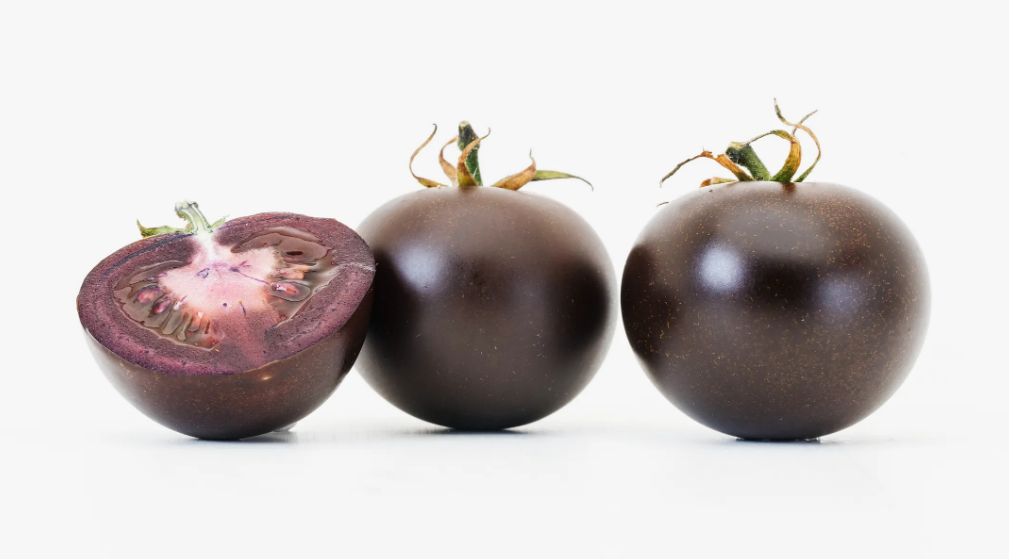
We’re coming up to the end of this year’s tomato season, and while it makes me sad, it also means we’re that much closer to next year’s tomato season! I’m hoping that will bring the debut of a new tomato that I just read about in Wired: a regally purple berry (yes, berry) that packs a major antioxidant punch.
The creators of this tomato genetically modified it with genes from a snapdragon, which boosts its colour and anthocyanin content — the same antioxidant found in blueberries and blackberries. Its gorgeous appearance marks a shift in GMO strategy: away from impressing farmers with yields and hardiness, and toward consumers trying to make healthier choices.
“Norfolk Plant Sciences, a company cofounded by [the purple tomato’s inventor, plant scientist Cathie] Martin, plans to roll out a purple cherry tomato in a handful of test markets in 2023. The biotech firm is also working on purple tomato juice, sun-dried tomatoes, and beefsteak tomatoes, and plans to sell seeds for backyard gardeners. ‘We hope people will eventually grow their own,’ says Martin. […]
While purple-skinned tomatoes have been developed through conventional breeding, they don’t accumulate high levels of anthocyanins in the flesh. There’s evidence from other researchers that these compounds may help prevent cancer, reduce inflammation, and protect against type 2 diabetes. And in a 2008 study, Martin and her team found that mice that were predisposed to developing cancer lived 30 percent longer on a diet supplemented with purple tomatoes than mice on a regular diet supplemented with normal red tomatoes. (Of course, animal studies don’t always translate to humans, and there are many lifestyle and genetic factors that may affect a person’s cancer risk.)”
The developers are hoping that the time of the “Frankentomato” has passed, and younger consumers who’ve seen the successful track record of GMOs in the food chain will be more willing to try a modified product, especially if health benefits are involved.
While the above-mentioned test markets will be in the U.S., I hope it goes well and Canada follows suit soon after. I’m intrigued by the flavour possibilities — tomato varieties can be so subtly different from one another. And what a spectacular Caprese salad or pizza sauce these jewel-toned beauties would make! I await the future of the tomato with glee — and will keep you updated.
Once upon a time, we had the luxury of never sparing a thought about our planet’s ability to support us. But things have been getting increasingly complicated as we uncover the unexpected fallout of our choices, making stewardship of our natural environment a tricky thing indeed.
The venerable Monterey Bay Aquarium has been doing some of this fancy footwork in the whale-saving department and taking an unexpected detour through seafood lovers’ plates. They’ve red-listed Atlantic lobster – that is, given it their lowest rating, “avoid,” in their Seafood Watch sustainability guide – in an effort to drive down demand for the crustacean. Commercial lobster fishing involves long vertical ropes, stretching from the trap on the sea floor to buoys on the surface, dotted throughout the migration route of the critically endangered North Atlantic right whale. The whales can get tangled in the fishing gear, which prevents them from swimming and feeding, and potentially causes their deaths.
demand for the crustacean. Commercial lobster fishing involves long vertical ropes, stretching from the trap on the sea floor to buoys on the surface, dotted throughout the migration route of the critically endangered North Atlantic right whale. The whales can get tangled in the fishing gear, which prevents them from swimming and feeding, and potentially causes their deaths.
“Other fisheries added to the red list include all fishing for Jonah crab, and other trap, pot, and gillnet fisheries. Gillnets are a wall of netting that hangs vertically in the water, while traps and pots also have vertical lines from the surface.
Oceana, a conservation pressure group, urged the US and Canadian governments to implement stronger measures to protect North Atlantic right whales. ‘It’s unfortunate that the government’s failure to update the safeguards to protect North Atlantic right whales is having such serious consequences on these [lobster] fisheries,’ said Gib Brogan, Oceana’s campaign director. […]
Strong fishing regulations were needed to avoid interactions and minimise the effects of interactions, he said. To give the species a fighting chance, the National Marine Fisheries Service (also known as NOAA Fisheries) should reduce the number of vertical lines and gillnets in the water and move to whale-safe fishing equipment, such as ropeless gear, Brogan said.
‘Ordering lobster or crab should not mean jeopardising the future of critically endangered North Atlantic right whales,’ he said.”
With fewer than 340 right whales in existence, it’s incredibly important to preserve as many individuals as possible. Doing so by informing lobster fans of the consequences of their favourite nosh is cleverly effective. Love of the delicacy may even drive the reforms right whales need if lobster enthusiasts band together. I’d be happy to sacrifice a few celebratory meals if it means taking responsibility for ourselves and caring for these gentle giants of the seas.
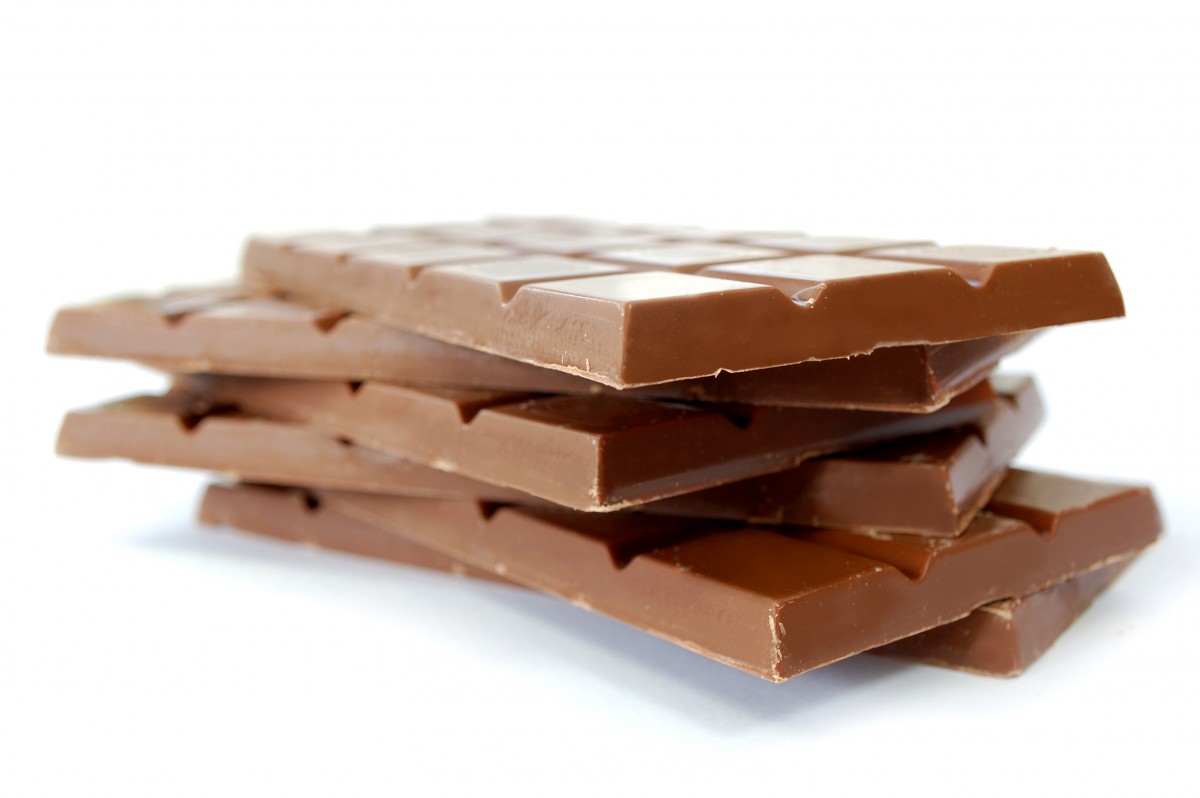
Now that it’s September, I’m resigned to the fact that fall is around the corner. One small silver lining is that the more the weather cools, the more comfort food we can enjoy – including chocolate! But there are some innovations happening in the confection sphere that will make chocolate even more enjoyable; not just for our tastebuds, but for our consciences too.
Several startups are working on “non-cocoa chocolate;” that it, lab grown sweets sourced from cell cultures, that are indistinguishable from the real thing in taste and texture. By decoupling the existence of chocolate from the cocoa bean, these companies hope to make tasty treats that are more resilient in the face of climate change and don’t also represent deforestation and child labour. But the situation is complicated, and also needs to take into account the economic impacts of small-scale farmers who supply many of the world’s cocoa beans.
“‘People have an emotional connection to chocolate that they don’t have to cornflakes,’ says Clay Gordon, author of Discover Chocolate: The Ultimate Guide to Buying, Tasting, and Enjoying Fine Chocolate, and a renowned cocoa industry observer and consultant. […]
Cocoa is especially vulnerable because it is predominantly grown by smallholder farmers. He says these farmers have no collective bargaining leverage and fair trade isn’t working to force major global companies to pay fair prices.
Gordon sees a market for lab-grown chocolate similar to the growing market for substitute plant-based meat products. It is not competitive in the short term and hence will not have an immediate impact on the cocoa industry which many in west Africa depend on. However, in the event of an unprecedented global climate event or ‘potential disruptors,’ the rise in the use of lab-grown chocolate and other food products could be impactful.”
It seems there are lots of factors these days that are causing this manufacturing pivot. It makes sense that developers are trying to get ahead of any one of these potential market enders. I know I’d be a lot happier with a treat that made the world happier too; from the farmers to the harvesters, to the general environment. If that chocolatey goodness flows from a place of responsibility and kindness, it’ll taste all the sweeter.

If you’ve heard anything about durian – a large, spiky-shelled, creamy-fleshed fruit with a delicately complex flavour – I bet it’s the fact that it’s banned on public transit in Singapore. That’s because of its overpoweringly noxious scent, variously described as garlicky, like “used socks,” and even “raw sewage”. Notoriously rule-heavy Singapore isn’t alone; many Southeast Asian locales have banned consuming or even transporting the fruit in public places, out of concern for the common good.
But great news has just arrived for durian fans who can’t keep their love to themselves. A fruit tree researcher in Thailand has engineered a durian subspecies, whose fruit retains all the joy for the tongue, without the wallop to the nasal cavity.
“This new type of durian is believed to be a branch of the popular Mon Thong variety grown in the province of Nakhon Ratchasima, northeast Thailand. Growers claim that the new durian variety is sweet, tender, and has no peculiar smell.
Currently, this odorless durian variety has been granted a trademark and geographical indication (GI) certificate by Thailand’s National Office of Intellectual Property, recognizing that the product originates from a specific geographical location and has prestigious quality credited to the region. […]
At present, the fruit is banned from most hotels, airlines and public transport in many Asian cities, such as Singapore. […]
In 2019, a durian was dumped near an air vent at an Australian university, prompting students and staff to evacuate the campus and call rescue teams to locate the source.”
Without its characteristic odour, will the acknowledged “king of fruit” lose any of its awesome grandeur? I doubt it – as we at DFC know, making your flavours more accessible means more popularity. I might even be inclined to try one of these scentless durians at home; I bet breaking it down would be a fun activity, much like one of my all-time faves, pomelo. And when I do, I’ll raise a slice in solidarity to those durian fans who can finally chow down on the train in peace!
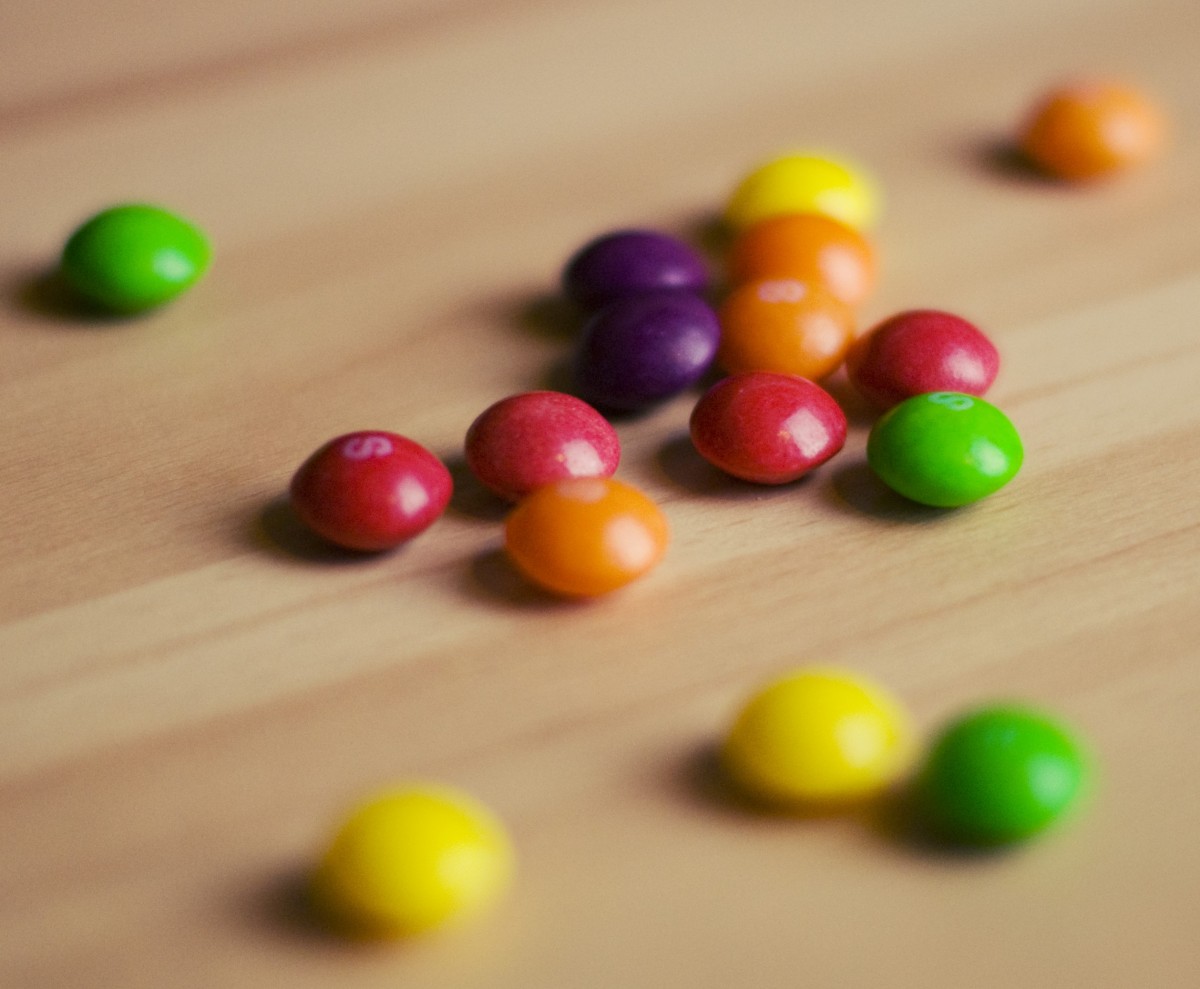
It seems American sweets can’t catch a break. First, it was sprinkles, banned by regulatory bodies in the UK as a non-legal source of the red dye E127. Now, a home-grown lawsuit is coming after the quite possibly cheerfullest candy the good old U.S. of A. has ever produced, Skittles. California resident Jenile Thames is suing the Mars Corporation over what the suit alleges are “heightened levels” of titanium dioxide in Skittles that are “not safe and pose a significant health risk to unsuspecting consumers.” Titanium dioxide is used extensively as an anti-caking and whitening agent in the paint, paper, plastic, cosmetic, and (in the U.S. at least) food industries. It’s been banned as a food additive in Europe, but it’s still used in American-made Skittles to make their rainbow colours really pop.
“‘Based on Defendant’s omissions, a reasonable consumer would expect that the Product can be safely purchased and consumed as marketed and sold,’ the complaint reads. ‘However, the Products are not safe and pose a significant health risk to unsuspecting consumers. Yet, neither before nor at the time of purchase does Defendant notify consumers like (Thames) that the Products are unsafe to consumers, contain heightened levels of titanium dioxide, and should otherwise be approached with caution.’
In 2021, the European Food Safety Authority (EFSA) halted the use of titanium dioxide when it announced that the substance ‘can no longer be considered safe as a food additive.’ And years before the EFSA made that announcement, Mars shared its plans to gradually remove titanium dioxide from its products. Although Mars’ plans were revealed in 2016, the company has yet to remove titanium dioxide from Skittles and other products.”
Mars has fired right back in a statement, saying that the titanium dioxide levels in Skittles remain below the FDA “danger” threshold – essentially passing the hot potato to the FDA. I have no idea how this suit is going to resolve, but I wonder if it might force a European-style pivot on the American FDA? Until then, I thank my stars it’s been years since I’ve tasted a Skittle. Apparently, I need all the power my system’s got to process those sprinkles…
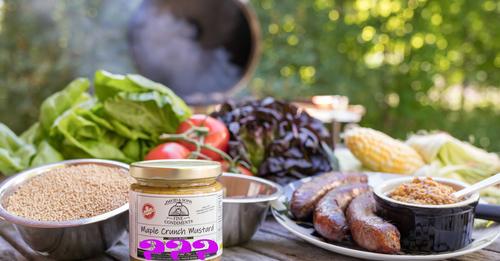
We’ve definitely been feeling the (40 degree?!) burn recently, but DFC has had the heat turned on another way: climate-change-related drought out west has led to shortage of our much-needed mustard seeds! Thankfully, the breadth of our product line means we can roll with a certain amount of scarcity, but that’s not the case with mustard-only outfits. Quartz looks at the particular case of France, the world’s biggest consumer market for mustard, and how companies there are struggling to meet demand with so little supply.
“At least 80% of the brown seeds come from Canada, Luc Vandermaesen, director of the Reine de Dijon mustard manufacturer and president of the Burgundy Mustard Association, told the New York Times. A heat wave across Alberta and Saskatchewan cut seed production by 50% last year. Even the smaller Burgundy harvest was hit hard by rising temperatures.
The shortage of seeds is already pushing up retail prices for Dijon mustard – which is used as a spread for sandwiches, a condiment for steak frites, and a crucial base for many classic French sauces – as much as 25%, Vandermaesen said. Some stores, when they have mustard in stock at all, limit customers to one jar per person. French chefs have resorted to appealing online for any spare mustard, and shoppers have come to the manufacturer’s headquarters – which does not sell the product itself – looking for the condiment.”
All of these strategies are stopgaps – purchasing limits, online appeals, even our pivoting to other sauce production. The reality of climate change means that we either have to fundamentally alter how we run our companies, or how we live on this planet. And we are rapidly running out of time to do the latter. I know we’re in the mustard business, so this may sound like heresy, but our planet is worth more than a jar of mustard – or a herd of dairy cattle, or a super yacht. But it looks like we humans can’t know the value of something until it disappears… Especially if it’s as small as a mustard seed.
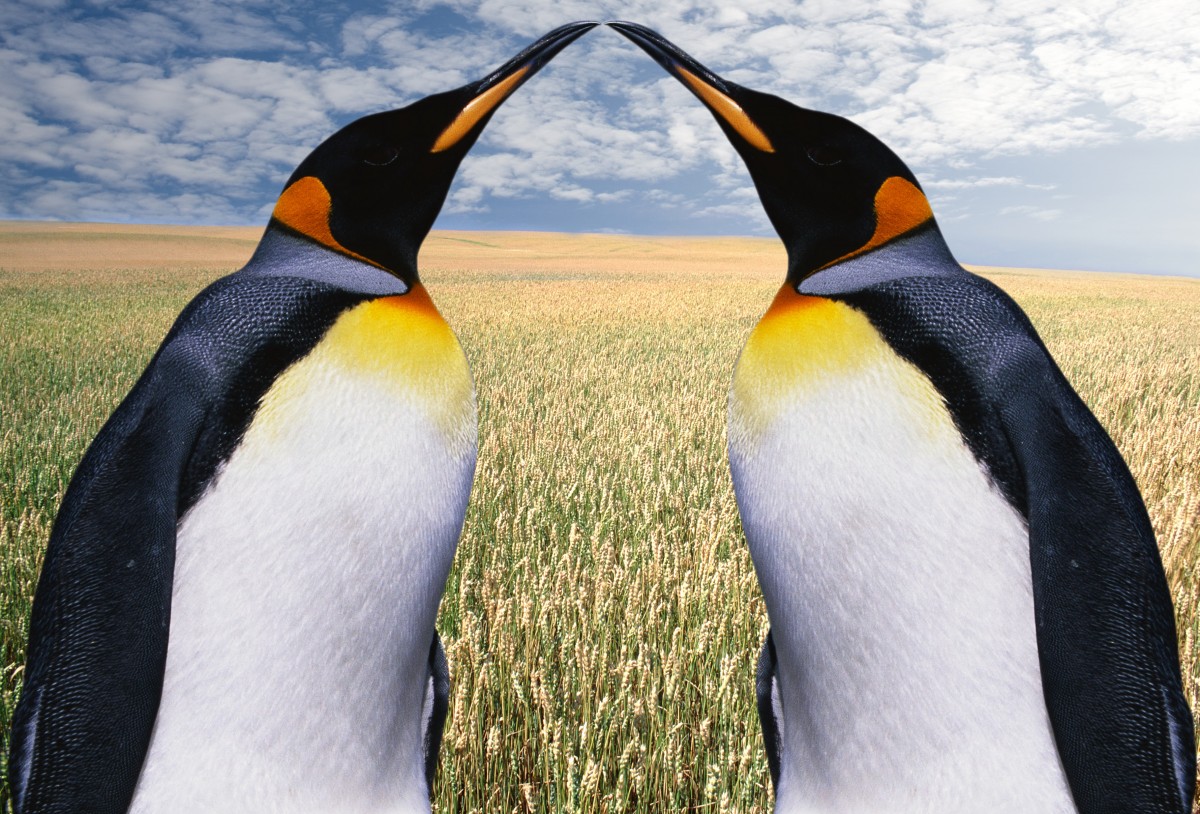
Once upon a time, we humans invented the concept of money to make trade easier; since then, the whole program has been getting increasingly complicated. These days, it seems everyone is tightening their belts to mitigate the effects of a fun new concept called inflation. This includes the Hakone-en Aquarium in Japan, where penguins, otters, and seals, who previously dined on fatty and delicious aji (horse mackerel), are now, due to budget constraints, being offered less-expensive (and slimier!) saba, or Atlantic mackerel. The animals, blissfully unburdened by human concepts like economics, know what’s what, and are outright refusing the dinner downgrade.
penguins, otters, and seals, who previously dined on fatty and delicious aji (horse mackerel), are now, due to budget constraints, being offered less-expensive (and slimier!) saba, or Atlantic mackerel. The animals, blissfully unburdened by human concepts like economics, know what’s what, and are outright refusing the dinner downgrade.
“In Japan, higher import costs and energy prices – caused by strains on the global economy due to the COVID-19 pandemic and the war in Ukraine – have shocked citizens. In April 2022, Japan’s consumer prices rose by 2.5 percent, the most since October 2014.
The cost of running the aquarium has risen by about 20 percent since the beginning of the year, [head zookeeper Hiroki] Shimamoto said, although he wasn’t authorized to say how much it spends on food. […]
Shimamoto said the aquarium first began transitioning its 20 penguins and five seals to cheaper mackerel in May, with only 10 percent of their diet being replaced by the lower-priced protein. It has tightened its belt gradually and starting July, about 30 to 40 percent of the mammals’ food will be cheaper fish.”
Unfortunately, keepers can’t explain to the animals why they have to start eating “off-brand” fish because of inflation, so they have to take this hunger strike in stride: Any animal that doesn’t eventually take to the saba will continue to be fed the high-test aji. Though we can’t talk to them, I think the penguins et al. are communicating clearly to us – how ridiculous this whole “money” thing is, at its core! Hmm, I love a bit of seafood, myself; maybe a pivot to a fish-based barter system wouldn’t be all bad…?

Invasive species have long been a problem all over our increasingly connected planet. However, the Illinois Department of Natural Resources is using a particularly modern strategy – P.R. – in an attempt to curb the presence of non-native carp in the state’s waterways. The four carp subspecies in question (bighead, brass, silver, and black) have spread widely since their North American introduction in the 1960s, out-competing local fish for resources and lowering general water quality. But they are also pretty tasty – a fact belied by their unappetizing name. Turning gross-sounding “carp” to cutely exotic “copi,” experts hope, will help humans make a feast-sized dent in the overall population.
“In addition to giving the fish a new name, the project brings together more than 30 restaurants, distributors, processors and retailers from across Illinois, Tennessee, Arizona, and Washington D.C., all working together to get copi on more plates. The project’s website even suggests recipes provided by participating restaurants, including copi fresh fish tacos, a copi firehouse fish burger and copi smoked fish dip. Funding for the project – $600,000 over five years – comes from the Great Lakes Restoration Initiative, a group of federal agencies working to protect the Great Lakes, the largest system of fresh surface water in the world.
The new name comes from the word ‘copious,’ a nod to the sheer abundance of these fish. It was thought up by Span, a Chicago-based communications firm, the AP reports. Fishermen could harvest 20 to 50 million pounds of copi from the Illinois River alone each year, per a statement from the Illinois Department of Natural Resources, with ‘hundreds of millions’ of additional pounds in other waterways.”
This is a fun tactic in our fight against invasive species – make delicious tacos out of them! It’s also a gentler way of, essentially, taking responsibility for our earlier mistakes. We’ve only got one world, and untangling the web we shouldn’t have woven can make life easier for the countless other-than-human organisms that share our space. If we can get a fabulous meal out of it too, that’s gravy!
Thanks to climate change, a fan favourite hot sauce will – like fjords melting under our increasingly temperate atmosphere – disappear from our dinner tables this summer. Huy Fong Foods Inc., purveyors of the classic, green-capped, garlicky bottles of Sriracha hot sauce (as well as a fiery sambal oelek and pungent chili garlic sauce) have publicly broken the news that a peppe r shortage will soon affect their output. Wholesale orders for all three popular sauces, which use the same, now-scarce, red jalapeño peppers, made after April 19th this year will be completed and shipped at the beginning of September. Huy Fong dropped the dire news in an email last week.
r shortage will soon affect their output. Wholesale orders for all three popular sauces, which use the same, now-scarce, red jalapeño peppers, made after April 19th this year will be completed and shipped at the beginning of September. Huy Fong dropped the dire news in an email last week.
“The company described the pepper shortage as ‘severe’ and related to the climate. The company sources its peppers from various farms in California, New Mexico and Mexico, and said that weather conditions were affecting the quality of the peppers and deepening the chili pepper shortage. […]
‘Unfortunately, this is out of our control and without this essential ingredient we are unable to produce any of our products,’ the company said. […]
Hot temperatures and a historic drought across the US west have been taking a heavy toll on California’s agriculture. The US Drought Monitor reported that the whole state was in ‘severe drought’ as of last week, with the Central Valley facing ‘extreme drought’ conditions.”
The Sriracha folks are no strangers to production hiccups; in 2013, a lawsuit brought by neighbours claiming that the aerosolized capsaicin emitted by the factory was a public nuisance caused production to grind to a halt, until the suit was dropped the next year. Non-committal language in their announcement aside, I’m betting the famously word-of-mouth-only, cult condiment will bounce back because that’s what the system does in the short term. The greater, long-term question is, will our planet bounce back?
We’re entering the time of year in southern Ontario where the early fruits start showing up. I’m lucky: my faves are strawberries, so, unlike apple or peach fans, I don’t have to wait too long to dig in!
I love a local fruit, so I was quite surprised to read about one I’d never heard of, via the BBC of all places. The pawpaw is a fragrant, mango-like, ancient fruit that grows wild in half the United States and into our neck of the woods. It has a huge fandom, but, as the pawpaw spoils a few days after being picked — and, as serious devotees attest, is truly ideal freshly harvested from the tree — that’s limited to a pretty short range around its habitat. Advocates have been spreading the word, though, and now science is listening.
“‘They are so delicious,’ said Michael Judd, author of For the Love of Paw Paws: A Mini Manual for Growing and Caring for Paw Paws – From Seed to Table. During the harvest season (typically a few weeks in late summer or early autumn), his diet consists mainly of pawpaws taken right off the branch. ‘It’s a nutrient-rich superfood,’ he added, listing off the pawpaw’s many attributes: antioxidants, all the amino acids, magnesium, copper, zinc, iron, potassium, phosphorus, vitamin C. […]
Iowa State University is developing a pawpaw variety with a longer shelf life and a larger fruit with fewer seeds.
Kentucky State University has a pawpaw programme too. ‘We’re interested in pawpaw from an ecological standpoint as a native plant that is losing habitat, and from a horticultural standpoint as a unique high-value fruit crop that can be grown sustainably since it’s well suited for the climate,’ said [KSU research associate Sheri] Crabtree. She noted that over the past 20 years she’s seen awareness of the fruit grow, driven by the shift toward sustainable and local food production and the Slow Food movement. Some of that attention is also driven by efforts to honour indigenous foods. As Mihesuah pointed out, ‘Tribes are attempting to protect and revitalise their traditional food sources, and pawpaws are an important part.’”
My envy at hearing of this fabulous fruit that I’ve totally missed out in quickly galvanized me to find out where in our fair province I could find them. The University of Guelph has a pretty vague map, and a cursory Google around implies that most wild stands are found by word of mouth, and generally protected by fans to prevent over-harvesting. Well, I may try my hand at growing them myself (in pairs of trees, as they don’t self-fertilize), or wait for Science to brew up those shelf-stable fruits that can be shipped up here. Either way, the day I finally taste a pawpaw will be memorable indeed!